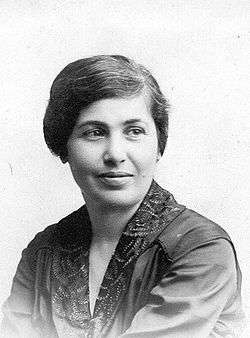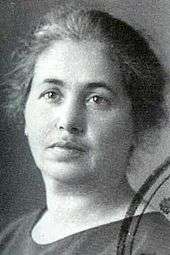Zabel Yesayan
Zabel Yesayan (Armenian: Զապէլ Եսայեան; 4 February 1878 – 1943) was an Armenian novelist, translator, and professor of literature.
Zabel Yesayan Զապէլ Եսայեան | |
|---|---|
 | |
| Born | 4 February 1878 Scutari, Istanbul, Ottoman Empire |
| Died | 1943 (aged 65) Siberia, Russian SFSR, Soviet Union |
| Occupation | Novelist, poet, writer, and teacher. |
| Nationality | Armenian |
| Alma mater | Sorbonne University |
| Spouse | Dickran Yesayan |
| Children |
|
| Signature | |
Biography
Zabel Yesayan was born on the night of February 4, 1878 as Zabel Hovhannessian, daughter of Mkrtich Hovhannessian in the Silahdar neighborhood of Scutari, Istanbul, during the height of the Russo-Turkish War.[1] The house she was born into was a reddish, two-story wooden structure.[2] She attended Holy Cross (Ս. Խաչ) elementary school. In 1895 she moved to Paris, where she studied literature and philosophy at the Sorbonne University in Paris, France. Inspired by the French Romantic movement and the nineteenth-century revival of Armenian Literature in the Western Armenian dialect, she began what would become a prolific writing career. Her first prose poem ("Ode to the Night")[3] appeared in Arshak Chobanian's periodical Tsaghik (Flower) in 1895. She went on to publish short stories, literary essays, articles, and translations (in both French and Armenian) in such periodicals as Mercure de France, L'Humanité, Massis, Anahit, and Arevelian Mamoul (Eastern Press).[4] While in Paris, she married the painter Dickran Yesayan (1874-1921).[5] They had two children, Sophie and Hrant.

Like Mari Beyleryan, Yesayan only returned to Istanbul after the Young Turk Revolution of 1908. In 1909 she went to Cilicia and published a series of articles in connection with the Adana massacres.[6] The tragic fate of the Armenians in Cilicia is also the subject of her book Among the Ruins (Աւերակներու մէջ, Istanbul 1911), the novella The Curse (1911), and the short stories "Safieh" (1911), and "The New Bride" (1911).
Yesayan was the only woman on the list of Armenian intellectuals targeted for arrest and deportation by the Ottoman Young Turk government on April 24, 1915.[7] She was able to evade arrest and flee to Bulgaria and then to the Caucasus, where she worked with refugees documenting their eyewitness accounts of atrocities that had taken place during the Armenian Genocide.

1918 found her in the Middle East organizing the relocation of refugees and orphans. To this period belong the novellas The Last Cup (Վերջին բաժակը), and My Soul in Exile (Հոգիս աքսորեալ, 1919; translated into English by G.M. Goshgarian in 2014),[8] where she exposes the many injustices she witnessed. Her support of Soviet Armenia was wholehearted, and in the novel Retreating Forces (Նահանջող ուժեր, 1923) she describes the social and political conditions of her time. She visited Soviet Armenia in 1926 and shortly thereafter published her impressions in Prometheus Unchained (Պրոմէթէոս ազատագրուած, Marseilles, 1928). In 1933 she decided to settle in Soviet Armenia with her children, and in 1934 she took part in the first Soviet Writers' Union congress in Moscow. She taught French and Armenian literature at Yerevan State University and continued to write prolifically. To this period belong the novella Shirt of Fire (Կրակէ շապիկ, Yerevan, 1934; translated into Russian in 1936), and her autobiographical book The Gardens of Silihdar (Սիլիհտարի պարտէզները, Yerevan, 1935; translated into English by Jennifer Manoukian in 2014).[9]
During the Great Purge she was abruptly accused of "nationalism" and arrested in 1937. She died in unknown circumstances: there is speculation that she was drowned and died in exile, possibly in Siberia, sometime in 1943.[6] Both the Soviet Concise Literary Encyclopedia (1964) and the Great Soviet Encyclopedia (1972) state Yerevan, 1937, as the place and date of her death.
Recognition
Lara Aharonian, founder of the Women's Resource Center of Armenia, and Talin Suciyan, Yerevan correspondent for the Turkish Armenian newspaper Agos directed a documentary film about her titled Finding Zabel Yesayan. It was released in collaboration with Utopiana and premiered on March 7, 2009.[10]
A street in Paris was renamed after Yesayan on 8 March 2018 during International Women's Day.[11]
In a 2019 interview, Turkish writer Elif Shafak indicated Zabel Yesayan's In the Ruins as her "favorite book no one else has heard of." Shafak described it as a "heart-rending cry, an important chronicle. A very important read."[12]
Posthumous publications
According to the Armenian International Women's Association (AIWA), several of Yesayan's works were published in the literary journal Pangaryus as part of AIWA's series called Treasury of Armenian Women's Literature. The materials were selected from the three volumes of Yesayan's work which have been translated into English. The works published included My home, an excerpt taken from Yesayan's memoir titled The Gardens of Silihdar; Yesayan's eyewitness account of the Adana massacre of 1909, titled In the Ruins; and a mystery story called The Man, which had previously been published in a collection called My Soul in Exile and Other Writings.[13]
List of works
- The Waiting Room (1903)
- The Obedients and the Rebels (1906)
- Phony Geniuses (1909)
- In the Ruins: The 1909 Massacres of Armenians in Adana, Turkey (1911)
- Enough! (1912-1913)
- The Agony of a People (1917)
- The Last Cup (1917)
- Murad's Journey from Sivas to Batum (1920)
- Le Role de la Femme Armenienne pendant la Guerre (1921)
- My Soul in Exile (1922)
- Retreating Forces (1923)
- Prometheus Unchained (1928)
- Meliha Nuri Hanim (1928)
- Shirt of Flame (1934)
- The Gardens of Silihdar (1935)
- Uncle Khachik (1966)[5][14]
References
- Ara Baliozian. The Gardens of Silihdar and Other Writings (1st ed.). New York, New York: Ashot Press. p. 53. ISBN 0-935102-07-8.
- Ara Baliozian. The Gardens of Silihdar and Other Writings (1st ed.). New York, New York: Ashot Press. p. 54. ISBN 0-935102-07-8.
- Yessayan, Zabel. "Ode to the Night". Ararat Magazine.
- Kevork Bardakjian (2000). A reference guide to modern Armenian literature, 1500-1920: with an introductory history. Wayne State University Press. p. 714.
- "Zabel Yessayan Project - Armenian International Women's Association". aiwainternational.org. Retrieved 2018-05-02.
- Ruth Bedevian. "WRITING - HER LIFE'S MISSION". An electronic library featuring a huge collection of documents on Armenian literature, history, religion and anything Armenia-related. Armenianhouse. Retrieved 10 October 2011.
- Atamian, Christopher (October 28, 2011), "Finding Zabel Yesayan, Finding Ourselves", Ararat Magazine
- Zabel, Yessayan (2014). My Soul in Exile and Other Writings. Translated by G.M. Goshgarian. Armenian International Women's Association (AIWA) Press. ISBN 978-0964878778.
- Yessayan, Zabel (2014). The Gardens of Silihdar: A Memoir. Translated by Jennifer Manoukian. Armenian International Women's Association (AIWA) Press. ISBN 978-0964878785.
- Armenian Reporter: Finding Zabel Yesayan, a film
- "Paris Street Renamed in Honor of Zabel Yesayan". Hetq. 9 March 2018. Retrieved 9 March 2018.
- Tamaki, Jillian (December 26, 2019). "The Turkish Novelist Elif Shafak Wants You to Read More Women". The New York Times.
- "Archives - Armenian International Women's Association". Retrieved 2018-11-23.
- hello@madebycat.com, madebycat®. "İstanbul Kadın Müzesi - Zabel Yesayan". www.istanbulkadinmuzesi.org. Retrieved 2018-05-02.
External links
| Wikiquote has quotations related to: Zabel Yesayan |
| Wikimedia Commons has media related to Zabel Yesayan. |